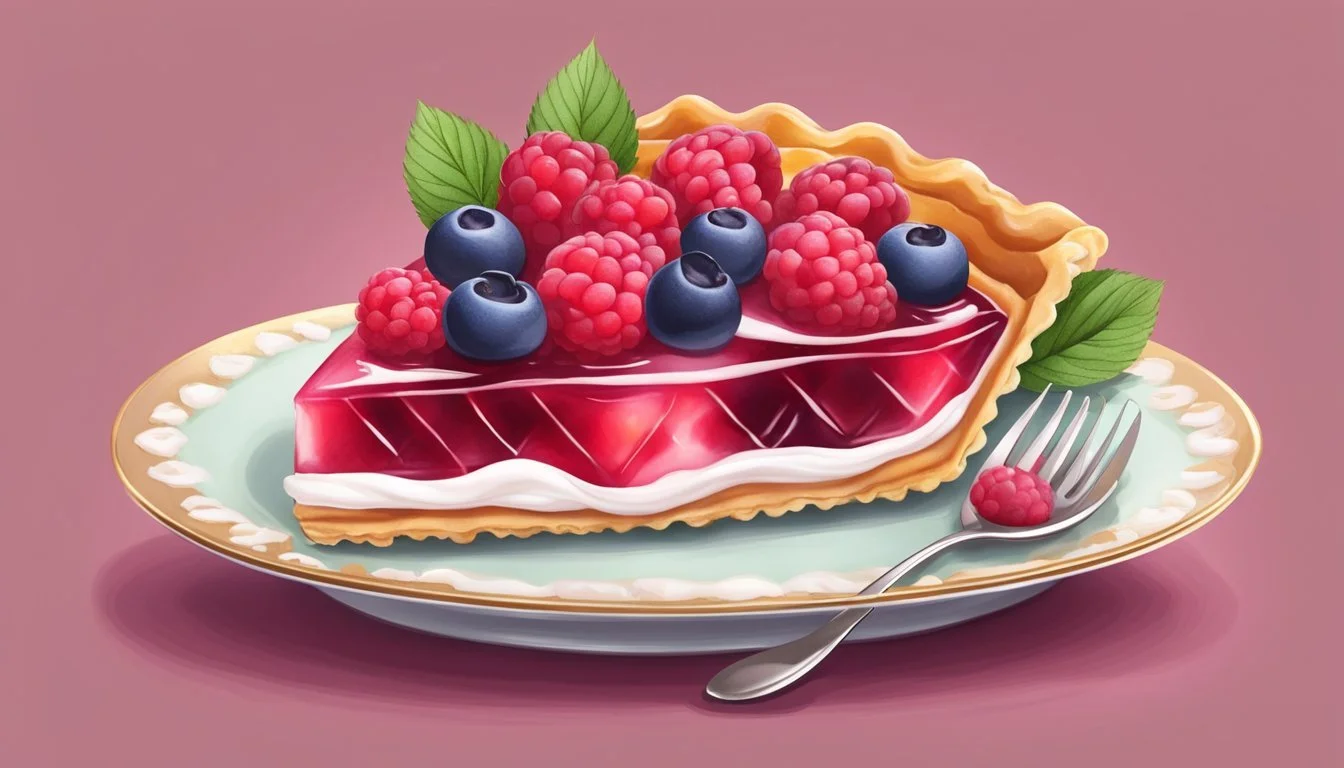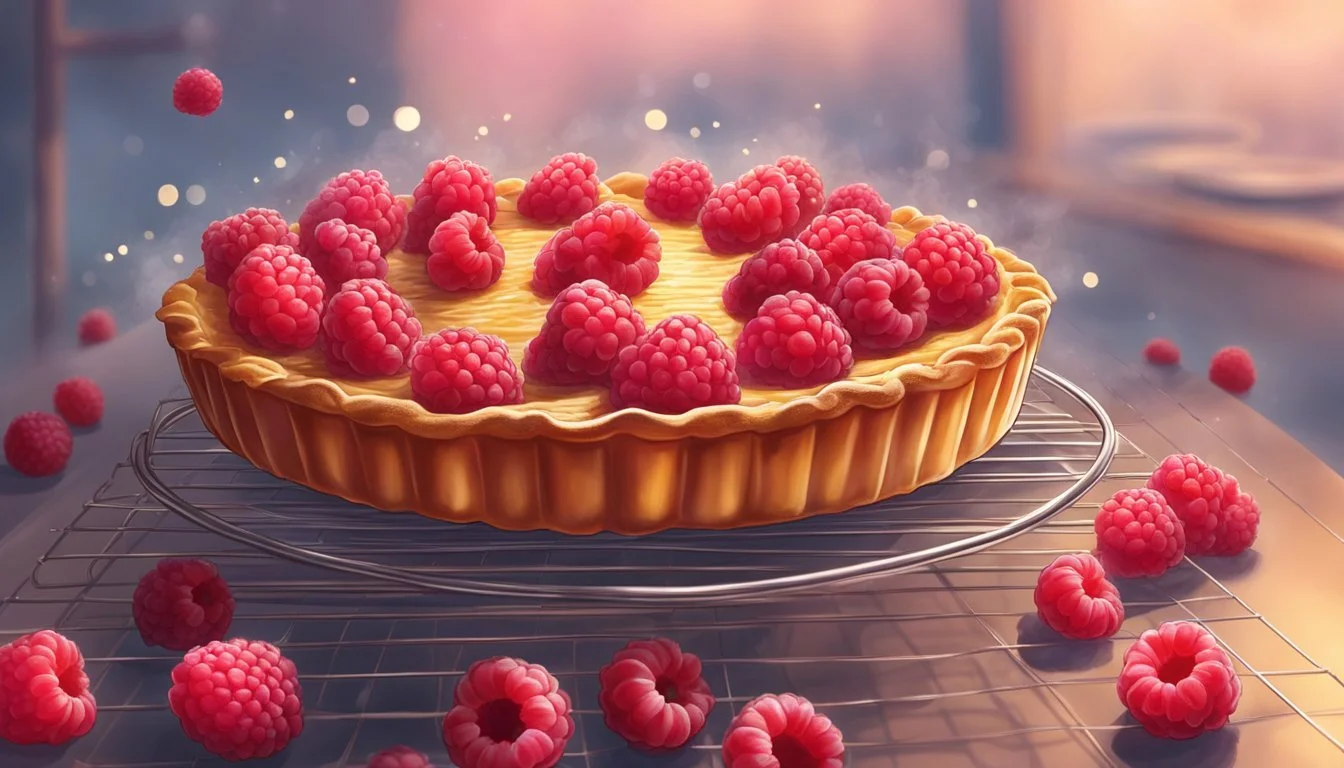How do you eat a raspberry tart?
Mastering the Art of Enjoying this Delicate Dessert
Eating a raspberry tart is a delightful experience that combines the sweetness of the raspberries with the flaky, buttery crust. This dessert, a classic in French patisserie and beloved worldwide, is as much a feast for the eyes as it is for the palate. The top layer usually consists of fresh or glazed raspberries sitting atop a creamy filling, such as pastry cream (how long does cream last?) or a raspberry curd, nestled in a crisp pastry shell.
To fully appreciate a raspberry tart, it is eaten with care to savor the combination of textures and flavors. With each bite, the initial burst of the raspberries' tangy flavor complements the sweet filling and the rich, crumbly texture of the shortbread or puff pastry crust. Whether enjoyed as a luxurious end to a meal or as a sumptuous mid-afternoon treat, a raspberry tart offers a balance of sweetness and acidity that satisfies dessert aficionados.
While there's no single right way to eat a raspberry tart, it is often consumed with a fork, allowing for measured bites that maintain the integrity of its delicate structure. For those wanting to enhance the dessert experience, pairing it with a dollop of whipped cream or a scoop of vanilla ice cream can add an extra layer of indulgence to this exquisite dessert.
Understanding the Basics
Eating a raspberry tart involves savoring a delightful dessert with a rich history and diverse flavors. Its intricacies begin with understanding what it is and the key components that constitute its deliciousness.
What Is a Raspberry Tart?
A raspberry tart is a dessert that features a crisp pastry crust filled with a vibrant raspberry filling. The fruit's natural tartness is delicately balanced by the sweetness in the filling, creating an enjoyable contrast enjoyed by many dessert aficionados. Tarts can come in many sizes, from large, shareable options to petite, individual servings.
Key Ingredients
The essential ingredients for a raspberry tart are as follows:
Raspberries: Fresh or frozen, they form the centerpiece of the tart.
Sugar: Typically granulated, it sweetens the tart to the desired level.
Butter: This provides a rich, flaky texture to the pastry crust.
Flour: Used for the crust, it gives structure to the tart.
Without these elements, a raspberry tart would not possess its classic flavor profile or texture that makes it a beloved treat in patisserie.
Preparation Essentials
To craft an exquisite raspberry tart, one must ensure the correct equipment is at hand, only the finest raspberries are selected, and the filling is prepared with precision.
Equipment Needed
Before commencing, having the right equipment is crucial. The essentials include:
Tart Pan: A 9-inch tart pan with a removable bottom aids in easy tart removal.
Mixing Bowls: Various sizes for different stages of preparation.
Hand Mixer: For whipping heavy cream to its perfect consistency.
Saucepan: Required for cooking raspberry custard to the right texture.
Whisk and Spatula: For blending ingredients smoothly.
Selecting Quality Raspberries
The star of the tart is undoubtedly the raspberries. One should choose:
Fresh Raspberries: Look for bright, plump berries that are free from mold. The fruit should be fragrant and firm to the touch.
Preparing the Filling
The filling is a combination of textures and flavors that should harmonize beautifully.
Raspberry Custard:
Egg Yolks: The richness comes from the yolks, providing a creamy custard base.
Fresh raspberries: They are either layered as is or cooked down into a jam.
Whipped Cream:
Heavy Cream: The cream, once whipped to soft peaks, gives a light and airy texture. It can be sweetened and flavored according to the recipe.
By meticulously readying each component, a divine raspberry tart awaits to tantalize the palate.
Creating the Crust
The foundation of a delicious raspberry tart is the crust—it sets the stage for the flavors and textures to follow. A proper crust should be buttery, flaky, and firm enough to support the filling.
Types of Tart Crusts
Tart crusts can be categorized into two main types: the classic, flaky pâte brisée and the sweet, rich pâte sucrée. The former is ideal for savory tarts, while the latter is more suited for sweet desserts (What wine goes well with desserts?) like raspberry tarts. Pâte sucrée often includes sugar and sometimes almond flour to add a delicate flavor and tender crumb.
Pâte Brisée: A traditional tart crust that is versatile and flaky.
Pâte Sucrée: Sweeter and more cookie-like, excellent for fruit tarts.
Making Pâte Sucrée
To create a pâte sucrée, one needs to mix together cold, diced salted butter with flour until the mixture resembles coarse crumbs. The addition of almond flour can enhance the flavor and texture. Precision in mixing is crucial to avoid developing too much gluten, which can lead to a tough crust.
Ingredients:
1 and 1/2 cups all-purpose flour
1/4 cup almond flour (optional for flavor)
2/3 cup powdered sugar
1/2 cup salted butter, cold and diced
1 egg
Combine the dry ingredients: sift together all-purpose flour and powdered sugar, and add almond flour if using.
Incorporate the butter: cut the cold butter into the dry ingredients until the mixture resembles a sandy mixture.
Bind the dough: add a beaten egg and mix just until the dough starts to come together, then gently knead into a disc.
Chill: wrap the dough in plastic wrap and refrigerate for at least an hour before rolling out to fit the tart pan.
Assembling the Tart
Assembling a raspberry tart involves careful layering of ingredients, followed by the addition of decorative elements to enhance both its visual appeal and taste.
Layering the Ingredients
The foundation of the tart is the pre-baked shell. Once the shell has cooled, the first layer to be placed in the shell is a pastry cream or chocolate ganache, depending on the recipe style. For a raspberry chocolate tart, the ganache provides a rich, decadent base.
Chocolate Ganache: Spread a smooth, even layer of ganache within the cooled tart shell.
Next, one will prepare the fresh berries. For a classic raspberry tart:
Fresh Berries: Arrange the fresh raspberries tightly against each other on top of the pastry cream or ganache to form a neat layer that covers the entire surface.
Decorative Elements
After the raspberries are neatly positioned, the tart can be adorned with decorative elements that not only add visual appeal but also complementary flavors.
Powdered Sugar: A light dusting of powdered sugar over the raspberries gives a subtle sweetness and a polished look.
If creating a raspberry chocolate tart, decorative elements can include:
Chocolate Drizzle: For an added touch of chocolate, one can drizzle melted chocolate over the top of the raspberries in a zigzag pattern.
A finished raspberry tart should boast a harmony of colors and textures, from the silky ganache to the vibrant, fresh raspberries, creating an indulgent dessert that appeals to both the palate and the eye.
Baking and Cooling
Proper heating and timely cooling are crucial to the success of a raspberry tart. Mastery over these steps ensures a perfectly baked dessert that retains its intended flavor and texture.
Preheat Oven
Before one begins mixing ingredients, preheating the oven is essential. For a raspberry tart, it's typically recommended that the oven be set to 350°F (175°C). This allows for an even and consistent cooking environment as soon as the tart is ready to bake.
Baking Time and Temperature
Baking Time: A raspberry tart generally needs to bake for a total of 25 to 35 minutes. This time can vary based on the specific recipe and the oven's characteristics. The tart should be checked periodically after the 20-minute mark to prevent overbaking.
Temperature: Maintain the oven at a steady 350°F (175°C). Some recipes may require a slight reduction in temperature after an initial period of baking, especially if the tart's edges are browning too quickly.
Cooling and Setting
Once baked, the tart must be allowed to cool completely at room temperature for the flavors to set and the structure to firm up. This can take approximately 20 to 30 minutes. Cooling not only enhances the tart's texture but also makes it easier to slice without the crust crumbling or the filling spilling out.
Serving Suggestions
When enjoying a raspberry tart, the experience can be greatly enhanced by accompanying it with the right additions. Careful pairings with creams and ice creams, as well as fresh fruit toppings, can turn a simple dessert into a delightful symphony of flavors.
Pairing with Creams and Ice Cream
Whipped Cream: A dollop of freshly whipped cream, lightly sweetened with sugar and perhaps enhanced with a hint of vanilla extract, complements the tartness of the raspberries. The cream's lush texture and the slight vanilla undertone enhance the tart's flavors.
Cream Cheese: (how long does cream cheese last?) For a richer alternative, consider a cream cheese blend. Whisking cream cheese with a little powdered sugar and vanilla creates a smooth, tangy accompaniment.
Vanilla Ice Cream: A scoop of classic vanilla ice cream is ample for a pleasing contrast. Its creamy sweetness balances the tart's fruit acidity and enriches each bite.
Adding Fresh Fruit Toppings
Blueberries and Strawberries: Introducing fresh blueberries and sliced strawberries not only adds to the visual appeal but also introduces complementary flavors. These berries can amplify the dessert's freshness and create a more varied taste profile.
Texture Contrast: Adding fresh fruits also provides a contrast in textures, with the juiciness and slight crunch of the berries juxtaposed against the creamy softness of the tart's filling and the crispness of its crust.
Additional Tips and Variations
Exploring different variations and proper storage and serving techniques can enhance the enjoyment of a raspberry tart.
Recipe Variations
Fruit Adjustments: Raspberry tarts are versatile. During raspberry season, one should opt for fresh raspberries for the best flavor. Outside the season, frozen raspberries are a suitable alternative, with the added benefit of year-round availability.
Flavor Twists: Adding a small amount of lemon juice to the raspberry filling can bring a refreshing zesty note to the dessert, playing off the sweetness of the raspberries. Vanilla extract is another popular addition, often included in the tart crust or filling to add a warm and comforting flavor.
Chocolate Variations: A chocolate raspberry tart introduces a rich contrast to the tartness of the raspberries. Incorporating melted chocolate into the crust or a layer of chocolate ganache under the raspberry filling creates a sophisticated and indulgent variant.
Storage and Serving Tips
Short-term Storage: A raspberry tart can remain at room temperature for a few hours when serving. For longer storage, refrigerating the tart is crucial to maintain freshness, typically for up to 3 days.
Long-term Storage: For extended storage, freezing is an option. It's recommended to freeze the tart without the fresh fruit topping, adding it after thawing to ensure texture integrity.
When ready to serve, one should carefully cut slices with a sharp knife, wiping it clean between cuts. Serving the tart chilled emphasizes the crisp crust and firm filling, providing an ideal textural contrast to the juicy raspberries atop.
Nutritional Information
The nutritional content of a raspberry tart can vary depending on the size and specific ingredients used in its preparation. Typically, such a dessert comprises a crust filled with a raspberry-based filling, sometimes enriched with creams or glazes for added flavor and texture.
A standard serving size of a raspberry tart may contain the following nutritional values:
Calories: The calorie count is often significant due to the crust and added sugars, with an average tart ranging from approximately 200 to 400 calories per serving.
Sugar: Sugar content can be high because of the fruit filling and any added sweeteners. It may range from 10 to 25 grams per serving.
Fat: Fat content mainly derives from the crust, as it is often made from butter or pastry dough. The fat content can vary from 10 to 20 grams, with saturated fat being a component to consider.
For a more health-conscious choice, one could opt for tarts made with a whole-grain crust and less added sugar. Below is a simplified nutritional profile based on a standard serving:
Nutrient Amount Calories 200-400 kcal Total Fat 10-20 g Saturated Fat Varies Carbohydrates Varies Sugars 10-25 g Protein Usually 1-5 g Fiber Varies, if whole-grain crust used
Consumers should read product labels for specific nutritional information, especially when considering store-bought or bakery-made raspberry tarts. Home cooks have the advantage of controlling ingredients to tailor the nutritional content to their dietary needs.
Conclusion
Consuming a raspberry tart is a delightful experience that is enhanced by the ease of its preparation. Third-person perspective emphasizes that one enjoys these elegant desserts at the peak of their freshness and texture. After chilling the tart to allow the fillings to set, it is ideal to consume it within a couple of hours—this ensures the crust retains its crispness and prevents it from becoming soggy.
To optimize enjoyment, it is recommended to:
Serve chilled: A cool raspberry tart offers the best blend of flavors and textures.
Use the right utensils: A sharp knife or a dessert fork ensures precise cuts without crumbling the delicate crust.
When discussing recipe simplicity, noting the tart’s simple ingredients and straightforward instructions is key. Many find the assembly process manageable and the required baking skills minimal, which makes this dessert favorable even for novice bakers.
In serving, one may choose to:
Garnish sparingly: A light dusting of powdered sugar or a dollop of whipped cream can complement without overpowering the raspberry flavor.
Pair wisely: A cup of coffee or tea pairs well with the tart's sweetness and acidity.
By adhering to these steps, one can ensure their raspberry tart is enjoyed in the most satisfying way possible. The balance of flavors, from the tartness of the raspberries to the sweetness of the curd, comes together for a delightful dessert experience.
FAQ
Eating a raspberry tart is a delightful experience that raises various questions on preparation and enjoyment. This FAQ section aims to address common queries and offers professional advice to enhance the tasting experience.
Common Questions
How does one minimize the tartness of a raspberry tart?
To reduce tartness, they can choose ripe, sweet raspberries for the filling. Adding a bit of extra sugar or a sweet glaze can also balance the flavors.
What is the typical prep time for a raspberry tart?
The average prep time for a raspberry tart is around 20 to 30 minutes, excluding baking and chilling times.
Pro Tips
Balancing Flavors: For those who prefer a less sharp taste, incorporating a sweet ganache can complement the tartness of the raspberries. They should carefully spread a layer of ganache beneath the raspberry layer for a luxurious twist.
Serving Temperature: A raspberry tart is best enjoyed when it has been chilled in the refrigerator, usually for at least 1 hour, to allow the filling to set properly and flavors to meld together.












